The Golden Pothos is, without a doubt, the golden child of the houseplant world.
Unlike other aroids, it won’t spit its dummy out if it doesn’t get the soil it wants or have a tantrum if it doesn’t get a drink of water right NOW or else. This beautifully behaved darling will make being a plant parent a walk in the park.
Oh, and just to avoid confusion, “Epipremnum aureum” is the species that encompasses all of the popular cultivars and varieties.
In this article, however, I’m specifically talking about the OG Golden Pothos, which is easily identified by its deep green leaves and beautiful yellow variegation.
Let’s get into it and discover how you can strike gold with your plant!
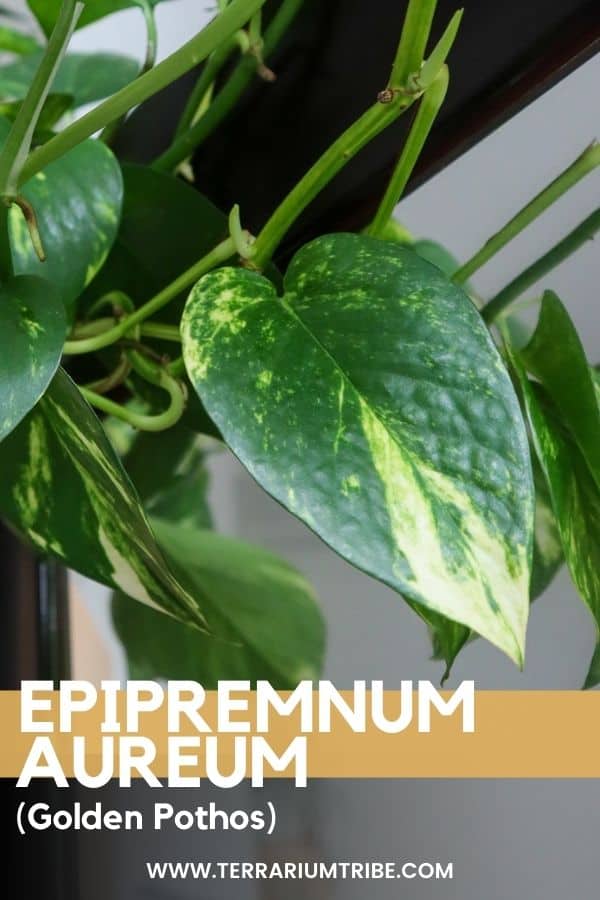
What is the Golden Pothos (Epipremnum aureum)?
Epipremnum aureum is a plant of wonderful qualities, stunning variegation, and many names. Known as the Golden Pothos, the Money Plant, and the Devil’s Ivy.
Why is a plant so angelic called Devil’s Ivy, you ask? Well, because it’s practically indestructible and grows like an absolute warrior.
Originally from French Polynesia, the Golden Pothos has spread across the globe like wildfire and is considered a highly invasive species. As a partially epiphytic (and aggressive) vine, it climbs up the native trees and can reach immense heights.
While bad for native trees, this makes the plant utterly fantastic as a houseplant – mother nature made this one a tough un!
Just a little love and know-how will have your plant thriving in no time.
Where to Buy Epipremnum aureum
See the links below to purchase from reputable terrarium plant shops and marketplaces (may include affiliate links).
Epipremnum aureum Care & Growth
At a Glance
| Plant Type | Vine, foliage |
| Lighting | Bright indirect light |
| Temperature | 60-90°F (15-32°C) |
| Watering | Moderate even moisture |
| Humidity | 60-95% moderate to high humidity |
| Growth | 10ft+ vine |
Light
Unsurprisingly, indirect bright light is best, but it’s certainly not worth stressing out over if you’ve run out of ideal spots (AKA indoor plant prime real estate).
Remember, in the wild, they climb up trees so they can grow both on the forest floor and when they peek through the dense foliage, too. Handy right?
I’ve had my beautiful Golden Pothos for over two years now, so from experience, I can tell you how she faired at both ends of the scale:
- Low light – This is where she was in my previous home. I had her there because a) I knew nothing about tropical plants and b) Pothos are famed for their “low light plant” status. She was fine there but hardly grew. They’re able to tolerate low light spots, but it’s certainly not their preference. You also could lose variegation if the plant struggles to photosynthesize.
- Direct light – *gasp* Yup. My plant has been in a spot where it gets some direct sunlight for at least 6 months and has had nothing but explosive growth. There’s a tiny bit of browning on some of the leaves and stems that are closer to the light source, but nothing drastic. The variegation is so much more bold and bright.
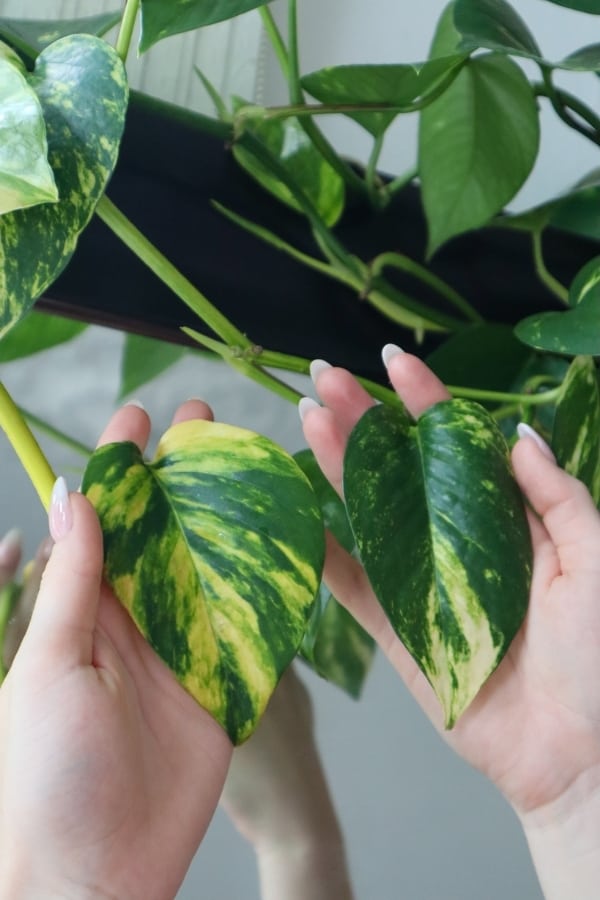
With that being said, I live in the Northeast of England, so my idea of bright light pales in comparison to some places.
So, I’d aim for bright indirect light, but if it get’s a little direct light (depending on where you live and the time of year) it’s nothing to worry about.
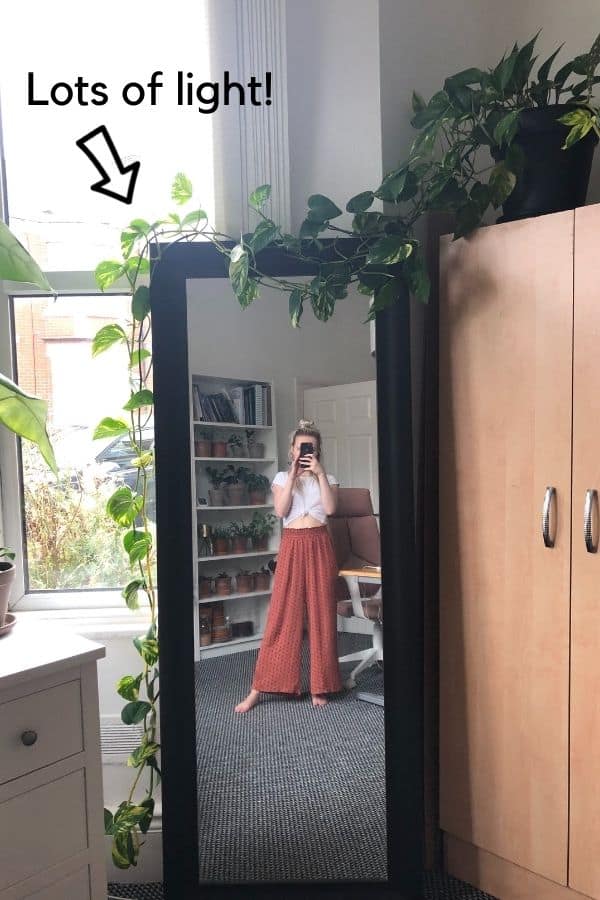
Watering
Watering is a breeze with a Golden Pothos.
A Karen in reverse, she’ll not run to trip advisor if she has to wait a little for her drinks, and if she gets more than she ordered she’ll likely be fine too.
But, while you have a very forgiving plant on your hands, naturally, you could run into some issues at either extreme.
Overwatering – If your Pothos is frequently sat in a soggy soil swamp, your plant might develop root rot which would result in yellow leaves and leaf loss. Sad times.
Underwatering – Conversely, yellow leaves and leaf loss can happen if you leave your Pothos too long without any water (to the point that it goes absolutely bone dry). This happened with ours because getting the ladders out is a right faff, and honestly, I put it off sometimes. She’s bounced back like a trooper, though!
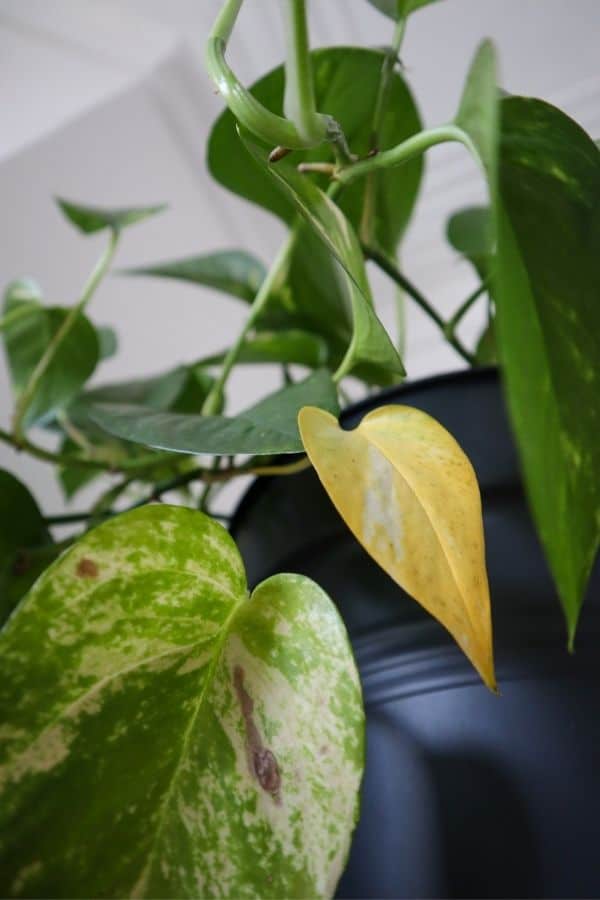
The best way to water is by giving her a drink whenever the soil is feeling a little dry to the touch.
A pot with a drainage hole really helps here – you can water until you see a little into the tray, tip the excess away, and then relax, knowing your Pothos isn’t sat in soggy soil.
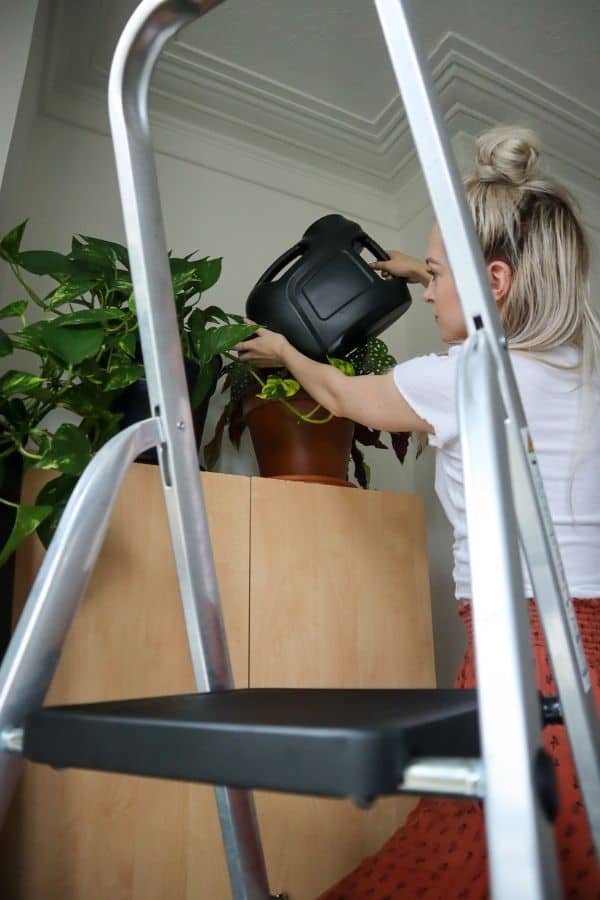
In a terrarium, I’d recommend being on the more reserved side with watering; try adding a little water at a time so you don’t drench the system.
Substrate
I’ve just had my Pothos in a simple, good-quality potting soil and had absolutely no issues there. By all means, it’ll appreciate a chunky Aroid mix, but it’s not necessary.
If you’re putting your plant in a terrarium, however, it’s crucial to get an appropriate substrate mix as it’s a closed system.
I like to use coco coir as a base with lots of orchid bark and for drainage and aeration. Using something like earthworm castings as a slow-release fertilizer is great, too.
And while we’re at it, the Pothos isn’t known to be a “heavy feeder” (which basically means a plant is fertiliser-hungry). So, as a houseplant, I’d go super easy on the fertilizer, if at all. Once or twice a year in the warmer months should be more than plenty.
Temperature & Humidity
To be honest, this section is fairly pointless.
As if something as trivial as temperature could hold back an Epipremnum aureum… It’s quite offensive, actually.
But, if you’re desperate to go above and beyond for your Golden Pothos, 60-90°F (15-32°C) is spot-on, and she’d almost certainly be okay with temperatures outside that range too.
I told you she wasn’t picky…
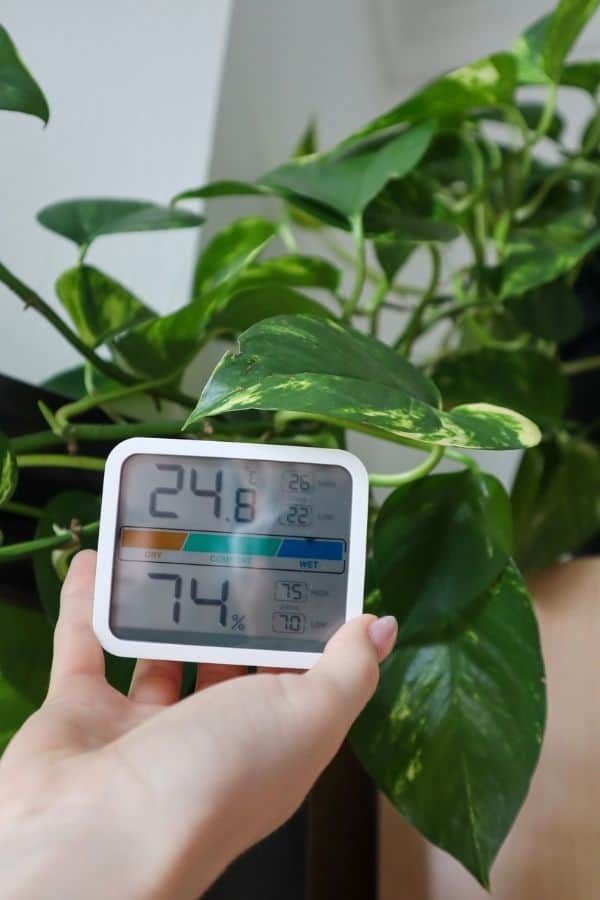
She will appreciate high humidity, though – hence why she’s a great fit for a terrarium. Anything in the 60%+ range is good, but the higher, the better. If the humidity is too low, then you might see crispy leaf tips and a little browning, though I’ve never seen that personally.
If you struggle to maintain high humidity for your plants, here’s how we do it:
- Keep our plants together.
- Dry our clothes in the room.
- Leave full watering cans around the room to evaporate.
It’s that simple!
Growth
Size matters and Pothos plants don’t need much persuasion to get their growth on.
After all, in nature, they’ve been recorded reaching 70+ ft high.
Yes, you read that right… seventy feet high.
Even indoor vines can achieve amazing length; my own plant is currently measuring in at 9ft long and shows absolutely no sign of stopping.
Every time I blink, it seems to grow another few inches!

What you’re unlikely to ever achieve in the home however, is the Pothos in all its glory in its final form.
Mature plants have absolutely massive leaves with fenestrations (splits) and can even flower!
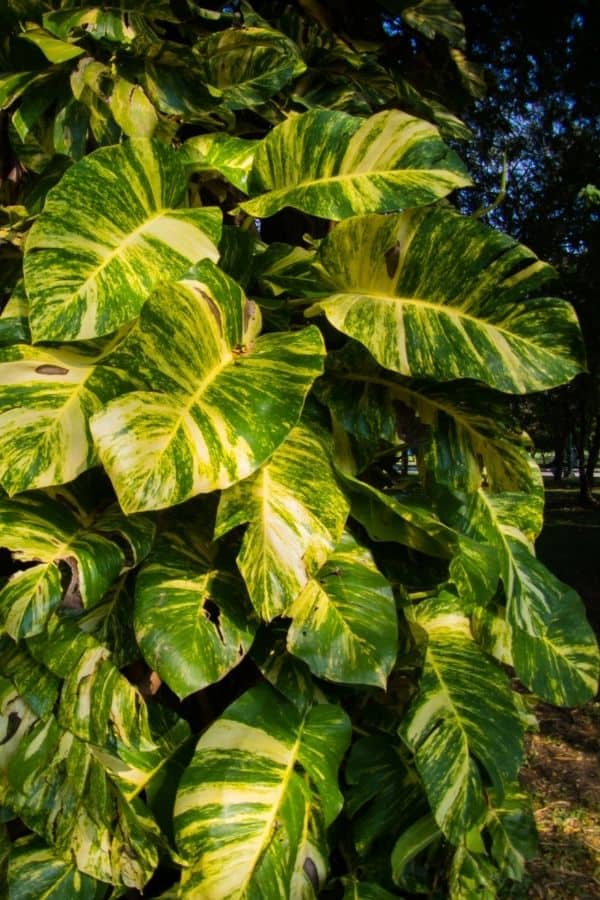
But the catch is that in order to carry out their growth cycle, mature vines really need to climb up something, as they would with the trees epiphytically in the wild.
So unless you have a 50ft moss pole (not to mention a ceiling) to facilitate this, it’s not gonna happen.
For that reason, I think Pothos look beautiful as a trailing plant or spilling out horizontally across a (large) terrarium floor. The length you can get with these plants is unparalleled.
With that being said, if it gets too long, don’t hesitate to give it the snip.
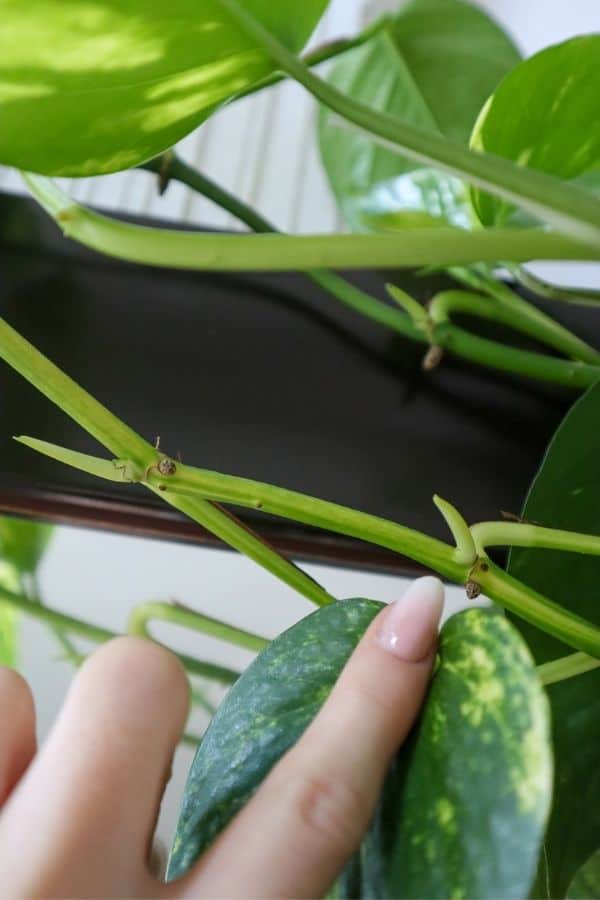
It can be maintained as a fuller plant, too, if you prefer. Regular pruning will promote a bushy growth habit and give you lots of stem cuttings to propagate. Win-win.
Which leads us to…
Propagation
Propagating a Pothos plant is easy-peasy lemon squeezy.
In fact, it was the first ever plant I propagated.
One of our favorite local venues was offering 10% off the bill if you brought in the plant, and as I’m sure you can imagine, we didn’t disappoint. I took my scissors to the Pothos and got us a discount…

All you need to do is snip beneath the root node (so you have a leaf and a node attached) and then stick it in a jar of water or a propagation station if you’re fancy.
After a couple of weeks, your cutting should be ready to plant up. I like to wait until the root is about 3 inches long or has baby roots coming from the larger root.
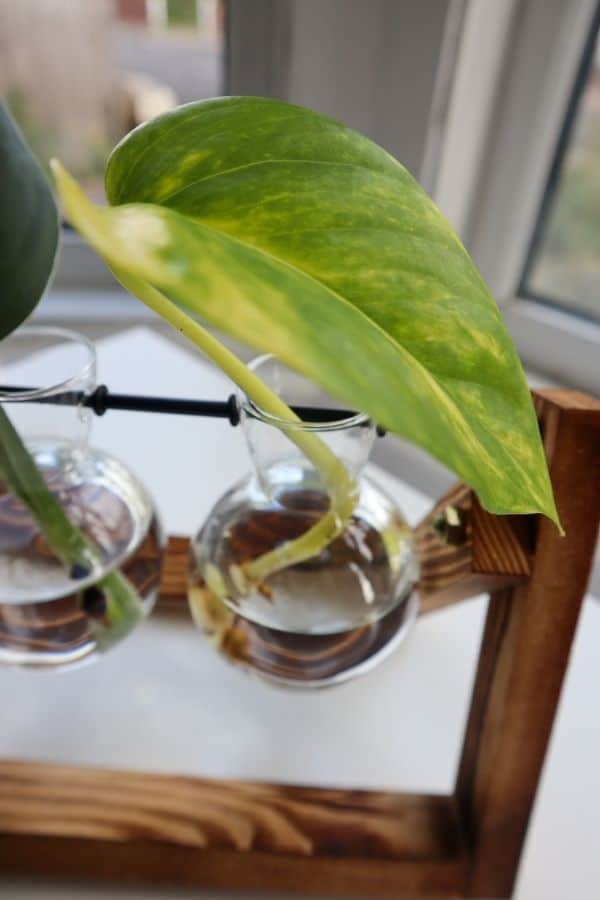
There you have it – you’re now the proud owner of not one Pothos, but TWO!
Rinse and repeat until they’ve overtaken your entire home.
Varieties & Similar Plants
Like Pokemon, whiskey, or vinyl records, Pothos are quite the collector’s item. Or at least they are in my world…
There are so many amazing, colorful, and variegated varieties to get your mitts on.
And luckily for you, I’ve written a complete list of each and every beautiful variety of Epipremnum aureum. Wahoo!
If you’re looking for more of an in-depth look, you can head straight to some of our other Pothos cultivar plant profiles:
- Neon Pothos (a lime green variety)
- Marble Queen Pothos
- Majnula Pothos
- Njoy Pothos
- Pearls and Jade Pothos
- Cebu Blue Pothos (which is actually an Epipremnum pinnatum)
- Satin Pothos (a show-stopping silver vine that is actually a Scindapsus but shhhh I won’t tell if you don’t)
Gotta catch em all!
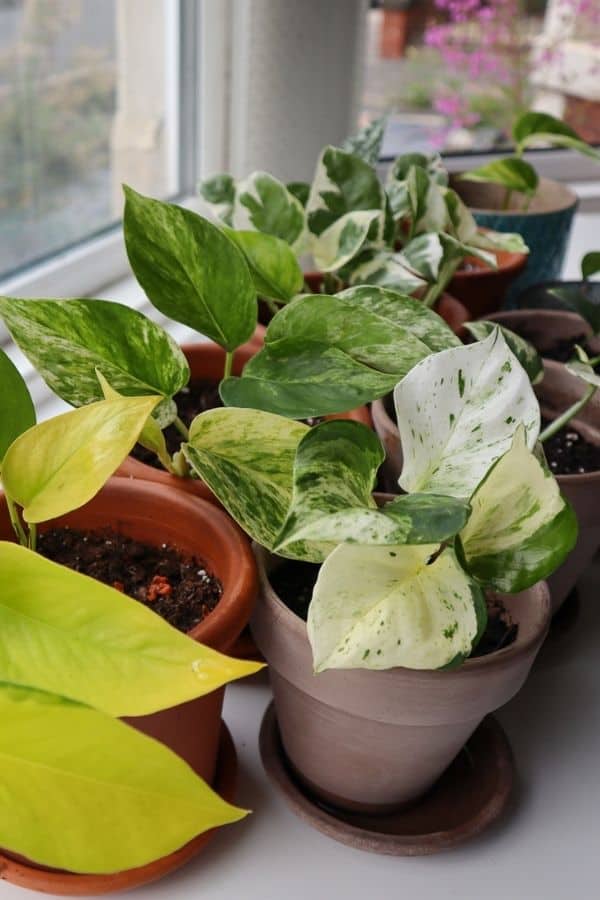
Frequently Asked Questions
Yes, all Pothos plants are toxic to both pets and people when ingested, which is why if you have little mouths in your home, we recommend keeping them in a terrarium where they can’t be reached.
In a study conducted in 2016 (by NASA, believe it or not), a Golden Pothos was found to remove formaldehyde and other compounds from the air. https://ntrs.nasa.gov/citations/20160005687
If your Pothos is losing variegation, it’s likely not receiving enough light, and it is reverting so it can photosynthesize – get it under a grow light or closer to a light source.
Yellow leaves on a Pothos are usually indicating an issue with underwatering or overwatering. Check the soil. Is it wet or dry to the touch?
Drooping and wilting are signs of underwatering in a Pothos. It’s the plant’s way of telling you it’s time to water!
Dripping water isn’t usually a problem – it’s called gutting and is your plant’s way of getting rid of excess water. Make sure you aren’t overwatering your plant and have a pot with drainage.
Pothos likely goes by “Devil’s Ivy” because, in the wild, it’s extremely invasive and can cause havoc for the local trees. It’s also very difficult to get rid of.
